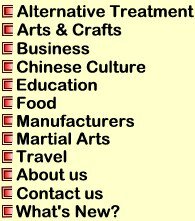|
|
|
|

|
|
||
| Summer: Hot - averages between 23C & 30C Winter: Mild and pleasant: 17C Typhoon: Gale force wind strikes several times a year between July and September. |
|||
|
|
|
|
|
You will probably visit Hong Kong as part of a tour group, which will include visits to many of the main tourist spots as part of the package. However, if you do have some time to spare there are other places within easy reach of your hotel that will not be on the usual itinerary. |
||
|
|
|
1) 3000BC - A stone tool found in New Territories verified the first settlement in this area. |
||
|
|
|
Hong Kong consists of Hong Kong Island (51.5 sq km), Kowloon (5.6 sq km), the New Territories (588 sq km), Lantau Island and more than 260 outlying islands. |
||||
 |
||||
|
|
|
|
|
|||
|
Sedan Chair for wedding ceremony |
Bearers waiting for customers |
|||
|
Sedan chairs are probably the oldest form of transport, both public and private, in the world. They were used extensively in England, throughout Europe and the Far East. |
||||
|
|
||||
|
|
 |
|||
|
Sedan chair with police sergeant passing by |
Carrying customers | |||
|
|
||||
|
|
||||
|
|
||||
|
|
||||
|
Rickshaw at the Star Ferry Concourse Kowloon. (the entrance to the old Kowloon Canton Railway station and the clock tower are in the background) |
||||
|
|
|
|||
|
Bamboo scaffolding in the background |
Rickshaw with customer |
|||
 |
||||
|
|
||||
|
|
|
|
|
|
Mr. R. Dibbs lived in Hong Kong for more than 25 years and is familiar & adapted to the life style of the Chinese culture, he can speak fluent Cantonese and plays Mahjong game with the Chinese. |
||
|
|
|
|